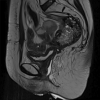Laparoscopic perineal hernia repair following pelvic exenteration: a case report
- PMID: 34006269
- PMCID: PMC8132409
- DOI: 10.1186/s12893-021-01237-9
Laparoscopic perineal hernia repair following pelvic exenteration: a case report
Abstract
Background: Acquired perineal hernia is a rare complication following extensive pelvic surgery. Radiotherapy is also a predisposing factor. Perineal hernia can cause chronic perineal pain, bowel obstruction, urinary disorders and a cosmetically disfiguring defect. The treatment of perineal hernia is surgical, usually consisting of mesh repair via an abdominal or perineal approach.
Case presentation: We present a case report and a surgical video of a 42-year-old woman with history of a squamous cell carcinoma. This patient had 3 recurrences since the diagnosis and a symptomatic perineal hernia. Complete regression of the recurrent malignancy allowed us to treat the perineal hernia. We performed laparoscopic repair with prosthetic mesh in this patient who had undergone multiple surgeries and radiotherapy, while preserving the omental flap that was used to reconstruct the posterior part of the vagina.
Conclusion: There is no consensus concerning the preferred surgical approach, perineal or laparoscopic, as no study has demonstrated the superiority of either of these approaches. Laparoscopic repair for an acquired perineal hernia is safe and feasible. However, further studies including randomized trials are required to precisely evaluate the best surgical approach and type of mesh.
Keywords: Abdominoperineal excision; Case report; Laparoscopy; Perineal hernia; Prosthetic mesh.
Conflict of interest statement
The authors declare that they have no competing interests.
Figures
References
-
- Drissi et al. Perineal hernias: diagnosis, management, prevention. e-mémoires de l'Académie Nationale de Chirurgie, 2017;16(2):065–068.
-
- Yeoman FC. Levator hernia, perineal and pudendal. Am J Surg. 1939;43:695–697. doi: 10.1016/S0002-9610(39)90626-4. - DOI
Publication types
MeSH terms
LinkOut - more resources
Full Text Sources
Other Literature Sources



